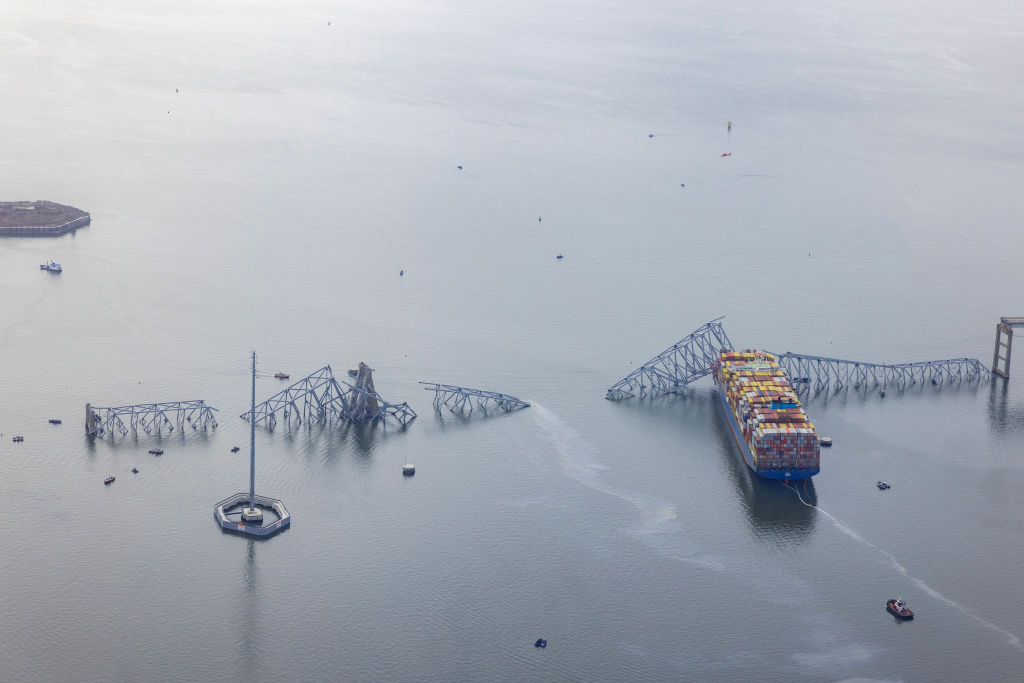29 March PunjabKhabarnama : The “black box” voyage data recorder (VDR) from the cargo ship, Dali, involved in the Francis Scott Key Bridge collapse has provided critical details about the moments leading up to the Baltimore tragedy. The pilot attempted to warn authorities of the impending disaster.
The Dali, a 984-foot Singapore-flagged vessel, lost power as it was leaving Baltimore Harbor and collided with the bridge around 1:27 a.m. on Tuesday, according to the National Transportation Safety Board (NTSB). The nearly 2-mile-long bridge, vital for East Coast shipping, collapsed into the Patapsco River within seconds.
In response to the collapse, local, state, and federal officials established a Unified Command. On Thursday, the command announced a halt to dive operations and vehicle recovery due to dangerous conditions in the river caused by the wreckage.
Coast Guard spokesperson Cynthia Oldham confirmed that the Dali’s 22-member Indian crew has remained on board since the incident, with no injuries reported. Eight construction workers were repairing potholes on the bridge when it collapsed. Two survived, while the others are presumed dead.
Experts estimate that rebuilding the bridge could take up to two years and cost at least $350 million, depending on the condition of the underwater foundation. U.S. Transportation Secretary Pete Buttigieg announced on Thursday that the first $60 million in federal emergency funds has been approved.
What did Dali’s black box record?
The Coast Guard recovered audio from the VDR on Tuesday and provided it to NTSB officials, investigator Marcel Muise said during a news conference on Wednesday night. Approximately six hours of VDR data from 00:00 to 06:00 EDT on March 26, 2024 has been handed over to the NTSB, and a team of experts will conduct a thorough analysis of the audio. The NTSB is continuing to obtain the remaining 30 days of data that the VDR is required to record.
The VDR also recorded limited system data such as ship speed, engine RPM, rudder angle, ship heading, and some alarm information.
Timeline of Events basis Dali’s black box data
The timeline provided by federal officials offers the most detailed account to date of the moments leading up to the disaster and will be the primary focus for investigators looking to understand the cause of the tragedy and how it could have been prevented:
At 00:30 EDT, the Dali set sail from its dock with the assistance of two tugboats. The ship carried 21 crew members from India, gearing up for a lengthy voyage to Sri Lanka.
By 01:07 EDT, the ship had entered the Fort McHenry Channel.
At 01:24 EDT, the Dali was navigating on a true heading of about 141 degrees within the Fort McHenry Channel, traveling at a speed of approximately 8 knots (9 miles per hour).
At 01:24:59 EDT, several audible alarms were detected on the ship’s bridge audio. Concurrently, the VDR system data stopped recording, but the VDR audio continued to be captured using its backup power source.
Around 01:26:02 EDT, the VDR resumed recording the ship’s system data, capturing steering commands and rudder orders on the audio.
At 01:26:39 EDT, the ship’s pilot broadcast a general VHF radio call, seeking assistance from tugs near the Dali. Data from the Maryland Transportation Authority (MDTA) indicated that the pilot association dispatcher had called the MDTA duty officer to report the power outage around this time.
At 01:27:04 EDT, the pilot instructed the Dali to drop the port anchor and issued further steering commands.
By 01:27:25 EDT, the pilot communicated over the VHF radio, reporting that the Dali had completely lost power and was approaching the Key Bridge. MDTA data confirms that the MDTA duty officer immediately instructed two units—one on each side of the bridge—to close it.
At around 1:29:00 EDT the ship’s speed over ground was recorded as just under 7 knots/8 miles per hour. From this moment until approximately 1:29:33, VR audio recorded sounds consistent with the collision with the Key bridge.
Additionally, around this time, an MDTA dash camera shows the bridge lights extinguishing. Additional analysis of the VR audio and comparison of other time sources will be needed to determine the exact time of contact between the DALI and Key Bridge.
At 1:29:39 the pilot reported the Key Bridge down over VHF to the USCG
By this point, all lanes of the bridge had been closed by the MDTA.
NTSB Chair Jennifer Homendy mentioned that the ship’s VDR is a basic system compared to an aircraft’s black box, providing only a snapshot of the major systems on a vessel. She expressed the agency’s long-standing desire for more comprehensive data recording.

